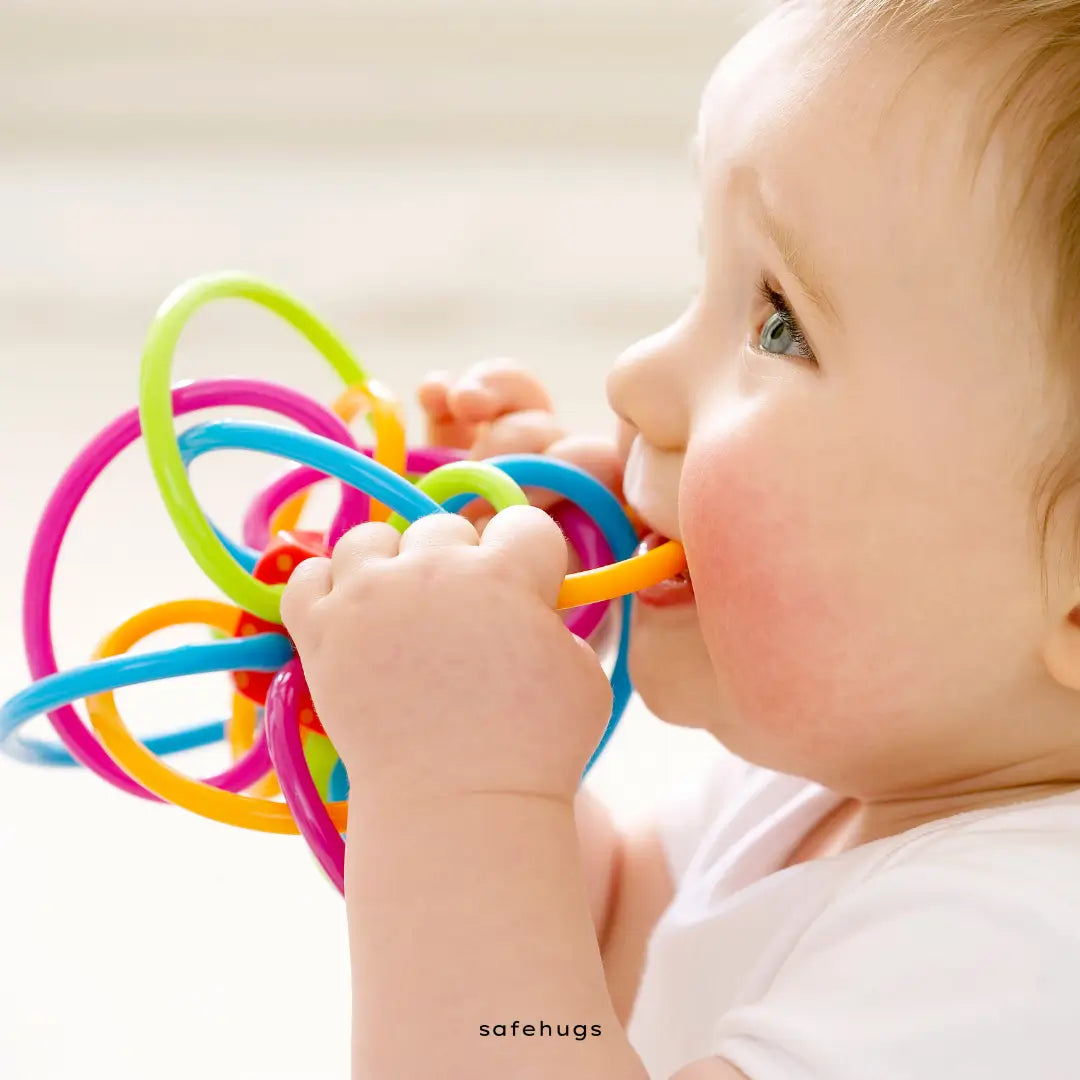Growth Spurts in Babies: Chart, Timeline & Symptoms
Table of Contents
- What Is a Growth Spurt In Infants?
- Signs Your Baby Is Going Through a Growth Spurt
- What Happens During a Growth Spurt In Infants?
- Growth Spurt Timeline in Babies
- What Is the 3-Month Crisis?
- How to Tell If Growth Is On Track
- Breastfeeding and Growth Spurts In Infants
- Growth Spurts in Toddlers and Kids
- How to Handle Growth Spurts
- Are Growth Spurts Preventable?
- When to See a Doctor
- Summary
- FAQs
Growth spurt meaning? Simply put, it’s a short phase when your baby or child suddenly seems to grow overnight - sometimes literally. They may need more sleep, more food, and definitely more snuggles. These growth spurts in infants can feel intense, especially for new parents navigating them for the first time.
Whether it’s your baby suddenly waking more at night or your toddler outgrowing clothes in weeks, growth spurts in infants are normal, healthy, and necessary. For babies, they often show up in the form of cluster feeding, fussiness, or sleep changes.
"It's like my baby was one size yesterday and another today - how is this possible?" - A question from one of our Mom Insider parent
We've spoken to pediatricians, child development experts, and most importantly, parents like you to answer the questions we hear the most:
- How do I know if it's a growth spurt or something else?
- Is it normal for them to eat or sleep this much?
- How can I make this phase easier for my child and for me?
What Is a Growth Spurt In Infants?
A baby growth spurt is a short period when your baby's body and brain grow rapidly almost overnight. You may suddenly notice they're hungrier, fussier, or sleeping more than usual.
It's not just physical growth. These spurts often include big changes in brain development, sensory awareness, and even emotional shifts.
Did You Know? Babies can grow up to 1 inch in just 24 hours during a growth spurt - that's faster than any other stage in life!
Growth Spurts In Infants Aren't Just About Height
Think of growth spurts like a mini "download" of new skills and size. During this time, babies are working hard behind the scenes to:
- Gain weight and length
- Build stronger bones and muscles
- Develop better coordination (like grasping or rolling)
- Increase awareness of surroundings and people
Mom Dilemma: "My 6-week-old suddenly feeds every hour and cries a lot. Is something wrong?"
Probably not. This is a textbook growth spurt sign. Babies often become clingier or crankier because their body is demanding more nourishment and comfort to support rapid growth.
Signs Your Baby Is Going Through a Growth Spurt
If your usually predictable baby suddenly seems off, they might be in a growth spurt. These periods come with clear but often confusing signs, especially if it's your first experience.

Here's how to tell the difference between a typical off-day and a growth spurt in progress.
1. Increased Feeding (Sometimes Constant)
Babies in a growth spurt often feed more, day and night. This is their body's way of asking for the extra fuel needed to grow.
- Breastfed babies may "cluster feed" every hour
- Formula-fed babies might finish bottles faster or want more than usual
This surge in feeding usually lasts 2-3 days, but it can feel endless in the moment.
2. Sudden Changes in Sleep
You might notice either of these two extremes:
- Longer naps or deeper sleep
- Frequent night waking or shorter naps
Their brains and bodies are in overdrive, and sleep helps them process it all.
3. Crankiness or Fussiness
If your baby seems unusually clingy, tearful, or easily frustrated, a growth spurt may be the cause.
- They may want to be held more
- Routine calming techniques may not work as easily
This emotional intensity is often overlooked but totally normal.
My baby has been quite restless. He sucks actively for 3 to 4 minutes and then turns his head away when I try to continue feeding him. He has also lost 50 grams. - Haritha, Mom Insider Community
4. New Skills Right After
One of the clearest signs? A leap forward in development soon after.
- Rolling over, holding up their head, babbling more
- Recognizing faces or following your voice
It’s as if their little system rebooted with an upgrade.
5. Clothes Suddenly Feel Tight
You might notice that:
- Onesies are snug even though they fit last week
- Sleep sacks and swaddles feel short
- Diaper sizes need an update sooner than expected
This physical change is the most visible and often the most surprising.
What Happens During a Growth Spurt In Infants?
A growth spurt is your baby's body switching to high gear. Within just a few days, their physical and brain development accelerate noticeably. Some of these changes are visible - others are working silently behind the scenes.
1. Physical and Neurological Development
- Height and weight often increase rapidly
- Brain development speeds up, especially during the early months
- New neural connections are formed, supporting memory, sensory processing, and movement
A study published in the Proceedings of the National Academy of Sciences found that infant brain volume can grow by nearly 1% per day during early growth spurts, a dramatic shift for such tiny bodies.
2. Bone and Muscle Growth
- Bones begin to lengthen quickly, especially in arms and legs
- Muscle tone improves, helping babies move with more coordination
- Some babies experience fussiness or mild discomfort, commonly called "growing pains"
"Growth spurts aren't just about getting taller - they're when babies start developing better control over their bodies." - Dr. Maya Iyer, Pediatrician
3. Hormonal Changes
- Growth spurts are triggered by increased release of growth hormone (GH), especially during deep sleep
- Hormones like leptin and ghrelin adjust, leading to noticeable changes in appetite, often sudden and intense hunger
In short: A growth spurt is a powerful, natural phase that touches every part of your baby's development - from their body to their brain, and even their sleep and mood. It's a sign that they're growing just as they should.
Growth Spurt Timeline in Babies
Growth spurts in babies follow a predictable timeline, but every baby is unique. Knowing when to expect them can help you prepare for those sudden changes in appetite, sleep, and mood.

Baby Growth Spurts Timeline

|
Age |
What to Expect |
|
7-10 days |
Baby may feed constantly and sleep more. A sign their body is adjusting to life outside the womb. |
|
3 weeks |
Cluster feeding begins. Some parents mistake this for a supply issue - it's usually not. |
|
6 weeks |
A major developmental leap. Expect fussiness, feeding marathons, and shorter naps. |
|
3 months |
Babies may sleep less during the day and wake up more at night. Appetite increases. |
|
6 months |
Growth slows slightly, but brain development surges. Sitting, rolling, and solid foods begin. |
|
9 months |
Motor skills and memory leap. Pulling up, crawling, and emotional clinginess may spike. |
|
12 months |
Cognitive and physical development surge. Early speech, independent walking, and heightened emotional sensitivity may emerge. |
When to Expect Growth Spurts in Babies
- Most growth spurts happen in the first year, especially in the first 6 months
- They can show up earlier or later for preemies or babies with different developmental patterns
- If your baby suddenly becomes hungrier, sleepier, or fussier - it may be a growth spurt, not illness
"Babies don't sleep continuously during growth spurts, so make sure your baby is getting frequent naps." - Shreeda, Mom Insider
How Long Do Growth Spurts Last?
- Typical length: 2 to 3 days
- Some can last up to a week
- Short, intense phases - followed by noticeable changes in size, weight, or milestones
Pediatric Insights:
Growth spurts often catch parents off guard. But when you know the timeline, they become less overwhelming and more meaningful.
What Is the 3-Month Crisis?
The 3-month crisis is a phase in your baby's development when they experience rapid physical and emotional changes, often due to a 3-month growth spurt. It typically occurs around the three-month mark and can make both you and your baby feel a little overwhelmed.
Developmental Changes:
- Babies start becoming more aware of their surroundings.
- They may have bursts of energy followed by moments of fussiness.
- You might notice more frequent crying or clinginess as they process their growing awareness.
Emotional Shifts:
- Emotional rollercoasters are common! Babies may feel extra sensitive or unsettled.
- This period often brings frustration as babies begin to realize they can't control everything around them.
How to Tell If Growth Is On Track
Tracking your baby's growth is a key way to ensure they're developing as they should. Growth charts are a helpful tool for monitoring milestones like weight, height, and head circumference. Here's how you can use them to check if your baby's growth is on track.
Using Growth Charts:
- Compare your baby's measurements: Growth charts from the World Health Organization (WHO) or the Centers for Disease Control and Prevention (CDC) are widely trusted. These charts use percentiles to show how your baby's growth compares to other babies their age.
- Look for consistent growth: It's not about the exact number, but about consistency. As long as your baby's growth stays steady within their percentile range, they're likely on track.
- Consider multiple measurements: Track weight, length, and head circumference during pediatric visits. A sudden, significant drop or jump in these can be a sign to pay attention to.
Remember, every baby grows differently, and slight fluctuations are normal as long as there's consistent progress.
Signs Something Else Might Be Going On
While growth spurts are a normal part of a baby's journey, sometimes symptoms can signal that there's more going on. Here's what to look for:
- Prolonged fussiness: If your baby is crying for hours and nothing seems to soothe them, it could be due to something like reflux or an illness.
- Poor appetite or vomiting: A consistent lack of interest in food or vomiting after feeding may indicate an underlying health issue.
- Unexplained weight loss or stagnation: A sudden drop or no gain in weight over several weeks is a red flag.
If you notice any of these signs, it's always a good idea to consult your pediatrician to rule out other potential concerns.
Breastfeeding and Growth Spurts In Infants
During a growth spurt, your baby's appetite can surge, leading to more frequent feeding sessions. This is often called cluster feeding, where babies want to nurse more often, sometimes every hour or so. This increase in feeding is a natural way for your baby to boost milk supply to meet their growing needs.
Nursing Patterns and Appetite Surges:
- During growth spurts like the 6-week growth spurt, babies may seem constantly hungry, often wanting to nurse for longer periods or more frequently. This doesn't mean you have less milk - it's just a phase where your baby's body demands more.
- Nursing sessions: It may feel like your baby is "snacking" more, but cluster feeding helps stimulate milk production and keeps your baby satisfied during growth periods.
- It's common to wonder, do breastfed babies gain weight slower? Breastfed babies may gain weight at a slower pace compared to formula-fed babies early on, but this is completely normal. Breastfeeding supports steady and healthy weight gain, with babies typically gaining around 4-7 ounces per week in the first few months.
Growth Spurts in Toddlers and Kids
Growth spurts don't stop after the newborn phase, they continue into toddlerhood and even adolescence. But the timing and intensity of these growth spurts can vary.
Toddler Growth Spurts:
-
When do toddlers have growth spurts? In toddlers, growth spurts typically happen around 18 months, 2 years, and 3 years. During these periods, you might notice your toddler eating more, sleeping more, or being extra cranky. Their appetite will surge to fuel their rapid physical growth.
What Month Do Kids Grow the Fastest?
-
Kids generally experience their fastest growth between 6 months to 2 years, where they can grow at a rate of about 10 inches a year. After this, growth rates slow down but continue steadily.
Key Differences in Growth Spurt Patterns Across Age Groups:
- Newborns: The early months are marked by steady, rapid growth. Most babies experience noticeable growth spurts at 2, 3, 6, and 9 weeks.
- Toddlers (1-3 years): Growth slows slightly but still occurs in spurts, particularly around 18 months, 2 years, and 3 years. Expect increased appetite and mood swings.
- Older Kids (4-10 years): Growth becomes more consistent, but occasional spurts may occur. This is a more gradual phase of development.
How to Handle Growth Spurts
How to deal with baby growth spurts? Growth spurts can be challenging, but with a little preparation and patience, you can support your baby through this natural phase. Here are some practical tips on feeding, sleeping, and emotional support:
Feeding Tips:
- During a growth spurt, your baby may want to nurse more frequently. This is normal and helps stimulate milk production. Allow your baby to nurse as often as they need without worry.
- Make sure you're drinking plenty of fluids and eating a balanced diet to support milk supply during this time.
- Sometimes babies use breastfeeding for comfort as much as for nutrition during a growth spurt. Let them nurse for emotional soothing as well.
Sleep Tips:
- Growth spurts can cause your baby to be more restless or require more sleep than usual. Offer extra comfort and be patient with any sleep disruptions.
- A consistent routine can help your baby feel secure and settle down more easily, even when their sleep patterns are a bit erratic.
Emotional Support:
- Your baby may be fussier than usual during a growth spurt. Offering plenty of physical affection can help them feel secure and comforted.
- Growth spurts can sometimes make babies more sensitive or clingy. These emotional shifts are temporary and are part of the natural developmental process.
Are Growth Spurts Preventable?
Are growth spurts preventable? No, growth spurts are entirely natural and are not something that can be avoided. They are an essential part of your baby's physical and emotional development. Babies go through these periods of rapid growth, and each spurt is a sign that they're developing as they should.
How to Prepare for Growth Spurts:
- Knowing that growth spurts are coming can help you manage the challenges they bring. Expect more frequent feedings, disrupted sleep, and increased clinginess.
- Growth spurts can test your patience, so be ready to offer comfort and support without feeling overwhelmed.
- Growth spurts often mean changes in appetite and mood, so keep your schedule flexible and adapt to your baby's needs during these times.
While you can’t stop growth spurts, preparing for them will help you navigate the ups and downs with a calm, understanding approach.
When to See a Doctor
While growth spurts are a normal part of your baby's development, there are times when it's important to consult a doctor. Here's when you should be aware of potential red flags and how to communicate with your pediatrician.
Red Flags to Watch For:
- If your baby isn't gaining weight consistently, it may signal a feeding issue or other concerns.
- Frequent vomiting or diarrhea could indicate an underlying health problem, such as an infection or food sensitivity.
- If your baby's fussiness seems excessive or is accompanied by other symptoms (like fever), it may be worth a visit to the doctor.
- If your baby consistently refuses to feed or struggles to latch, this could be a sign of illness or discomfort.
- If you notice your baby isn't reaching typical developmental milestones, like holding their head up or making eye contact, consult a pediatrician.
Your pediatrician is your partner in helping guide you through these concerns. Trust your instincts if something doesn't feel right!
Questions to Ask Your Pediatrician
When you visit your doctor, having the right questions can help you understand your baby's health better. Here are some key questions to ask:
- Is my baby's weight and growth on track?
- Are the growth patterns I'm seeing typical for my baby's age?
- What can I do to support my baby during a growth spurt?
- Should I be concerned about any of the feeding patterns I'm noticing?
- When should I follow up if the growth spurt symptoms don't resolve?
These questions can give you valuable insight into your baby's growth journey and reassure you about their development.
Summary
- Growth spurts typically occur in the first few months, around 3, 6, and 9 weeks, with patterns continuing into toddlerhood and adolescence.
- Signs of a growth spurt include increased hunger, changes in sleep patterns, and more emotional sensitivity.
- Supportive steps include extra feedings, adjusting sleep routines, and providing emotional comfort during these periods.
- Trust your instincts if something feels off, don't hesitate to consult your pediatrician.
As a parent, your intuition is one of your most powerful tools. If something doesn't feel right, reach out to your pediatrician. Trusted medical sources such as the CDC and American Academy of Pediatrics offer additional guidance on baby health and growth.
For further reading, visit CDC’s Growth and Development Guidelines and consult your healthcare provider for personalized advice.
Related:
- Check out our blog on Milk bleb treatment.
- Check out our blog on Vaccination Schedule in India for Kids.
- Check out our blog on Top 10 Parenting Apps For Indian Parents.
- Check out our blog on Top WhatsApp Groups for Moms in India.
- Check out our blog on Top 10 Parenting Blogs in India.
- Check out our blog on WhatsApp Support Groups for Single Parents.
FAQ'S
1. Are growth spurts and sleep regressions connected?
Yes, they often happen around the same time. Growth spurts can lead to more frequent feeding and disrupted sleep, which may overlap with sleep regressions.
2. Can growth spurts cause fever or illness?
No, growth spurts don’t cause fever. If your baby shows signs like high fever or vomiting, consult your pediatrician to rule out illness.
3. How do I know if it’s hunger or a growth spurt?
If your baby feeds more often, seems hungry quickly after feeding, and is growing well, it's likely a growth spurt. Trust your instincts and feed on demand.
4. Why is my baby sleeping more?
Extra sleep is common during growth spurts. It's the body’s way of supporting development. If sleep seems excessive or your baby shows other symptoms, check with your doctor.





























